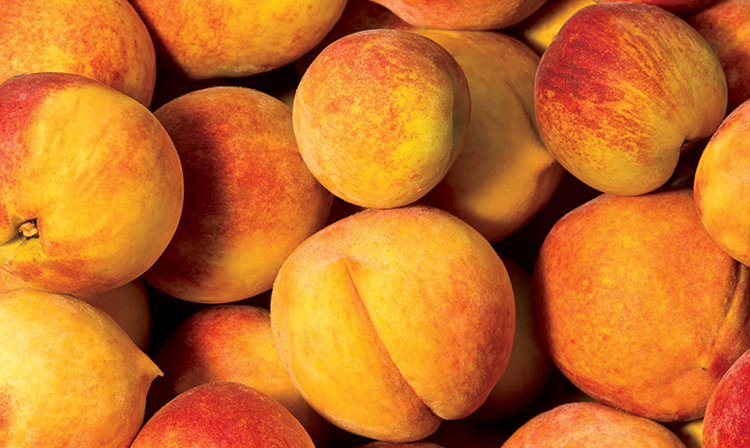Home > South Carolina > South Carolina Crops & Livestock > South Carolina Peach Growers are Blushing with Pride
South Carolina Peach Growers are Blushing with Pride

Chalmers Carr admits he’s lucky. With 5,000 acres of peach trees on his property at Titan Farms in Ridge Spring, he has his pick of some of the best peaches in the country. Summer Gold, O’Henry and Blaze Prince are three of his favorites, but those aren’t the only South Carolina peaches that will make your mouth water.
“South Carolina has the perfect climate for growing outstanding peaches,” Carr says. “The combination of rich, acidic soils combined with the proper mixture of humidity and 70-degree summer nights is the most ideal environment for developing optimum flavor and allowing the natural ripening processes to occur.”
Larry Yonce agrees. His farm, Big Smile South Carolina Peaches, is located not far from Titan Farms on the Ridge, where nearly 80 percent of the state’s peach crop is grown. “The acidic soil structure in the Ridge area excites the sugars in the fruit, which gives our peaches a real taste advantage,” says Yonce.
![South Carolina peach [INFOGRAPHIC]](https://eadn-wc01-4177395.nxedge.io/wp-content/uploads/2020/05/Screen-Shot-2015-04-22-at-10.52.54-AM.png)
The sandy, loamy soil in the northeast part of the state produces a sweet peach, too.
Kemp McLeod and his son, Spencer, grow peaches on 900 acres in McBee. “Our soils are very sandy here,” says McLeod, a fourth-generation farmer. “But that’s an advantage, because it helps us control the water. Even if we get a lot of rain, the soil won’t get too wet and that’s great for enhancing the sugar content.”
The sweet South Carolina peach reaches consumers across the country; more than 90 million pounds of peaches traveled across the United States in 2015. South Carolina peaches are sweet in number, too. S.C. is second only to California in peach production. Titan Farms alone grows more peaches than the entire state of Georgia.

Sweet Success
While climate and soil provide the sweet taste, the success of the peach business is built on the commitment of producers big and small across the state. Growing peaches is a labor of love.
“Every tree, every limb is pruned by hand,” says Yonce, who estimates he has close to half a million trees on his farm. “Plus, the window for getting that pruning done is about 90 days.”
Then there’s the task of thinning, which is removing excess fruit from the tree to meet market size needs. Next is the harvest process. Hand picking of ripe peaches begins in mid–May and continues through September. Yonce says each variety is harvested three to four times on a 48- to 60-hour interval.
All of those steps require a lot of labor and a lot of speed, due to the fruit’s perishability. Strong management skills are also essential.
![South Carolina peach [INFOGRAPHIC]](https://eadn-wc01-4177395.nxedge.io/wp-content/uploads/2020/05/Screen-Shot-2015-04-22-at-10.52.26-AM.png)
“There are a lot of pieces to manage,” says Carr. “There are financing challenges, infrastructure decisions, innovation opportunities to examine and labor concerns to address. But most of all, it comes down to having a vision and seeing it come to fruition, whether that’s growing and cultivating the fruit itself or growing and cultivating a company culture.”
And even when all these pieces fall into place, there’s still the weather to contend with. Peach growers have to be resilient and patient.
“Weather can make or break you,” says McLeod. He points to hailstorms in the early 1960s that almost wiped out his family’s business, which was founded by his great-great grandfather in 1916. With their centennial around the corner, McLeod Farms has found a way to weather many storms.
“You face these challenges and take pride in producing a good, wholesome product in the right way,” he says. “We’re lucky to be able to say we’ve been doing that in South Carolina for 100 years.”
![South Carolina peach [INFOGRAPHIC]](https://eadn-wc01-4177395.nxedge.io/wp-content/uploads/2020/05/Screen-Shot-2015-04-22-at-10.52.39-AM.png)



